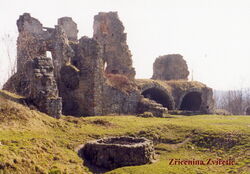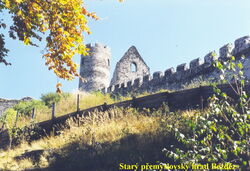 Walking the remaining one third of the Mácha Path (Máchova Cesta) from Okna, where we last finished, would be way too easy and that’s why we offer you a rather richer option, jazzed up by another interesting ruin. This time, we have to get off the train in Bakov nad Jizerou – outside the station we make a right turn and take the blue footpath and in about 15 minutes, following a short and undemanding ascent, we will find ourselves at Zvířetice, a ruin dating back to the 14th century, and godforsaken since 1720 when it was consumed by fire. From atop its tower we can get a picturesque view over the surrounding landscape and the vale of Jizera River. The only thing you need to keep in mind is - while making your way up the tower - that the stairs have their best years behind them. So….. hop it! We’ll follow the blue footpath a little further, across meadows and fields to Bítouchov and then through the forest, till we reach Bělá pod Bezdězem. At the very edge of this former royal town we switch to the red footpath leading downtown where we can find a Baroque chateau, a Renaissance town hall, remains of timbered housings and a parochial church with its unique Pieta carving.
Walking the remaining one third of the Mácha Path (Máchova Cesta) from Okna, where we last finished, would be way too easy and that’s why we offer you a rather richer option, jazzed up by another interesting ruin. This time, we have to get off the train in Bakov nad Jizerou – outside the station we make a right turn and take the blue footpath and in about 15 minutes, following a short and undemanding ascent, we will find ourselves at Zvířetice, a ruin dating back to the 14th century, and godforsaken since 1720 when it was consumed by fire. From atop its tower we can get a picturesque view over the surrounding landscape and the vale of Jizera River. The only thing you need to keep in mind is - while making your way up the tower - that the stairs have their best years behind them. So….. hop it! We’ll follow the blue footpath a little further, across meadows and fields to Bítouchov and then through the forest, till we reach Bělá pod Bezdězem. At the very edge of this former royal town we switch to the red footpath leading downtown where we can find a Baroque chateau, a Renaissance town hall, remains of timbered housings and a parochial church with its unique Pieta carving.
Let us leave Bělá by taking the green footpath, in the direction of the 3 km distant Valdštejnsko, a clearing amidst woods, where the Count of Valdštejn had six Baroque pavilions built in 1724 - these were meant for rest during the hunts. Nowadays, we can find only two of the original pavilions and out of the whole array of sculpture decorations only the grenadier ones in  the count colors are left. The signpost at the crossroads will tell you to follow the blue footpath, across the Valdštejn forests all the way to Bezděz, where you come across the red-signed Mácha Path again. This castle, built by order of Přemysl Otakar II in the 13th century and located on a phonolite hill at 604 m above sea-level, was the infamous place of imprisonment for queen Kunhuta and her underage son, Václav II, where they were kept under lock in very severe conditions by Otto Margrave of Brandenburg. One of the best preserved sites of the castle’s precincts is the early Gothic chapel, where you can even listen to period music, should you be taking the guided tour. The Big tower, 30m high, offers a marvelous view not only of the surrounding Mácha region in its entirety, but of the not-far-away mountain ranges as well – the massif of Ještěd and the picturesque view of Bohemian Paradise (Český ráj) with Krkonoše (the Giant Mountains) and Jizerské hory in its background. The other donjon, a 20m high round tower is called the Devil´s tower (Čertova věž). The adjacent wooded hill, called Malý Bezděz (Lesser Bezděz), is a nature reserve area with wildwoods harboring a unique niche of Rosalia longicorn (Rosalia Alpina, an insect for those of you who are unfamiliar with the subject of insectology!). Following the tour, perhaps even after a nice square meal to be had in one of the many restaurants in the village down below the castle, we have only some measly 7 kilometers of the Mácha Path ahead of us. Down the red footpath, along the Malý Bezděz hillside and then via the sandy paths down to Doksy, whose surroundings, together with Velký Hirschberský rybník – what is today called Máchovo jezero – are the settings for Máj, Mácha’s most celebrated lyrical poem. The history of this town, founded for the sole purpose of protection of trade routes leading to Mělník or Žitava, goes back to the 13th century, while the pond itself was founded somewhat later by order of Charles IV. The little isle of Myšlín used to be guarded in the 14th century by Myší Hrádek stronghold; however, today it serves together with the other isle – called Kachní ostrov – as an ornithological preserve.
the count colors are left. The signpost at the crossroads will tell you to follow the blue footpath, across the Valdštejn forests all the way to Bezděz, where you come across the red-signed Mácha Path again. This castle, built by order of Přemysl Otakar II in the 13th century and located on a phonolite hill at 604 m above sea-level, was the infamous place of imprisonment for queen Kunhuta and her underage son, Václav II, where they were kept under lock in very severe conditions by Otto Margrave of Brandenburg. One of the best preserved sites of the castle’s precincts is the early Gothic chapel, where you can even listen to period music, should you be taking the guided tour. The Big tower, 30m high, offers a marvelous view not only of the surrounding Mácha region in its entirety, but of the not-far-away mountain ranges as well – the massif of Ještěd and the picturesque view of Bohemian Paradise (Český ráj) with Krkonoše (the Giant Mountains) and Jizerské hory in its background. The other donjon, a 20m high round tower is called the Devil´s tower (Čertova věž). The adjacent wooded hill, called Malý Bezděz (Lesser Bezděz), is a nature reserve area with wildwoods harboring a unique niche of Rosalia longicorn (Rosalia Alpina, an insect for those of you who are unfamiliar with the subject of insectology!). Following the tour, perhaps even after a nice square meal to be had in one of the many restaurants in the village down below the castle, we have only some measly 7 kilometers of the Mácha Path ahead of us. Down the red footpath, along the Malý Bezděz hillside and then via the sandy paths down to Doksy, whose surroundings, together with Velký Hirschberský rybník – what is today called Máchovo jezero – are the settings for Máj, Mácha’s most celebrated lyrical poem. The history of this town, founded for the sole purpose of protection of trade routes leading to Mělník or Žitava, goes back to the 13th century, while the pond itself was founded somewhat later by order of Charles IV. The little isle of Myšlín used to be guarded in the 14th century by Myší Hrádek stronghold; however, today it serves together with the other isle – called Kachní ostrov – as an ornithological preserve.
Tour of this little town, with its well-preserved historic heart and a Renaissance chateau converted into Baroque style, as well as the early Baroque church, brings our journey via the Mácha Path, during which we covered 25 kilometers, to its end. In order to get back, you can take the train from Doksy to Bakov nad Jizerou, where you need to change to trains running to Prague or Turnov. Another option would be to take the bus, running from Jablonné v Podještědí via Doksy, Dubá and Mělník, terminating in Prague – although this line runs on Sundays only and tends to be a bit crowded.
